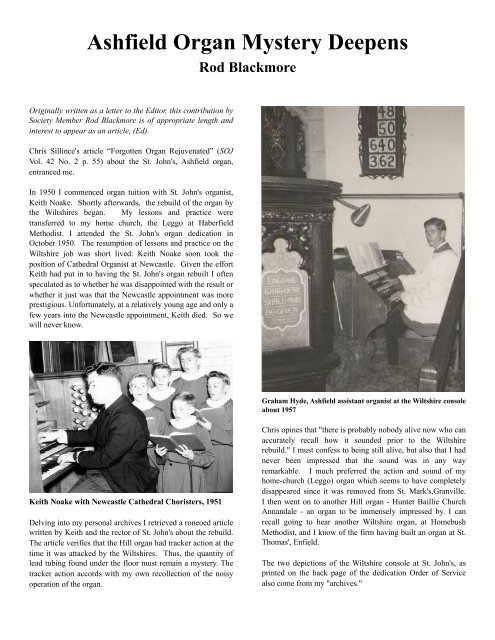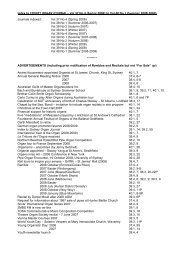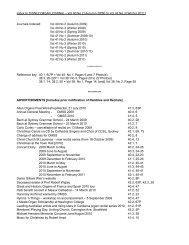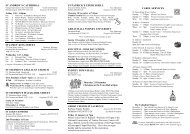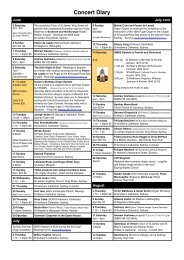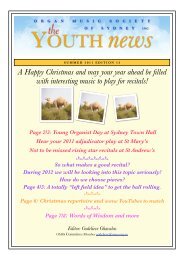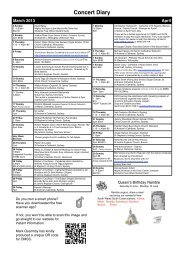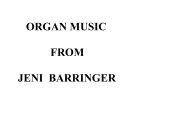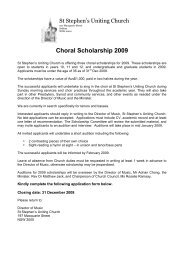Ashfield Organ Mystery Deepens - The Organ Music Society of Sydney
Ashfield Organ Mystery Deepens - The Organ Music Society of Sydney
Ashfield Organ Mystery Deepens - The Organ Music Society of Sydney
Create successful ePaper yourself
Turn your PDF publications into a flip-book with our unique Google optimized e-Paper software.
<strong>Ashfield</strong> <strong>Organ</strong> <strong>Mystery</strong> <strong>Deepens</strong><br />
Rod Blackmore<br />
Originally written as a letter to the Editor, this contribution by<br />
<strong>Society</strong> Member Rod Blackmore is <strong>of</strong> appropriate length and<br />
interest to appear as an article, (Ed).<br />
Chris Sillince's article “Forgotten <strong>Organ</strong> Rejuvenated” (SOJ<br />
Vol. 42 No. 2 p. 55) about the St. John's, <strong>Ashfield</strong> organ,<br />
entranced me.<br />
In 1950 I commenced organ tuition with St. John's organist,<br />
Keith Noake. Shortly afterwards, the rebuild <strong>of</strong> the organ by<br />
the Wiltshires began. My lessons and practice were<br />
transferred to my home church, the Leggo at Haberfield<br />
Methodist. I attended the St. John's organ dedication in<br />
October 1950. <strong>The</strong> resumption <strong>of</strong> lessons and practice on the<br />
Wiltshire job was short lived: Keith Noake soon took the<br />
position <strong>of</strong> Cathedral <strong>Organ</strong>ist at Newcastle. Given the effort<br />
Keith had put in to having the St. John's organ rebuilt I <strong>of</strong>ten<br />
speculated as to whether he was disappointed with the result or<br />
whether it just was that the Newcastle appointment was more<br />
prestigious. Unfortunately, at a relatively young age and only a<br />
few years into the Newcastle appointment, Keith died. So we<br />
will never know.<br />
Graham Hyde, <strong>Ashfield</strong> assistant organist at the Wiltshire console<br />
about 1957<br />
Keith Noake with Newcastle Cathedral Choristers, 1951<br />
Delving into my personal archives I retrieved a roneoed article<br />
written by Keith and the rector <strong>of</strong> St. John's about the rebuild.<br />
<strong>The</strong> article verifies that the Hill organ had tracker action at the<br />
time it was attacked by the Wiltshires. Thus, the quantity <strong>of</strong><br />
lead tubing found under the floor must remain a mystery. <strong>The</strong><br />
tracker action accords with my own recollection <strong>of</strong> the noisy<br />
operation <strong>of</strong> the organ.<br />
Chris opines that "there is probably nobody alive now who can<br />
accurately recall how it sounded prior to the Wiltshire<br />
rebuild." I must confess to being still alive, but also that I had<br />
never been impressed that the sound was in any way<br />
remarkable. I much preferred the action and sound <strong>of</strong> my<br />
home-church (Leggo) organ which seems to have completely<br />
disappeared since it was removed from St. Mark's,Granville.<br />
I then went on to another Hill organ - Hunter Baillie Church<br />
Annandale - an organ to be immensely impressed by. I can<br />
recall going to hear another Wiltshire organ, at Homebush<br />
Methodist, and I know <strong>of</strong> the firm having built an organ at St.<br />
Thomas', Enfield.<br />
<strong>The</strong> two depictions <strong>of</strong> the Wiltshire console at St. John's, as<br />
printed on the back page <strong>of</strong> the dedication Order <strong>of</strong> Service<br />
also come from my "archives."
A Century <strong>of</strong> <strong>Organ</strong> <strong>Music</strong> at St. John’s, <strong>Ashfield</strong><br />
A historical account <strong>of</strong> the music <strong>of</strong> the Parish<br />
in connection with the <strong>Organ</strong> Dedication Festival 1950.<br />
(written by F.A.S. Shaw, Rector and K.A. Noake, <strong>Organ</strong>ist & Choirmaster)<br />
<strong>Organ</strong>s have made a real contribution to the beauty <strong>of</strong> St.<br />
John’s services for one hundred and five years. <strong>The</strong> first<br />
instrument was a keyboard reed organ known as a seraphine,<br />
presented by the Bishop’s registrar, which served from the<br />
consecration in 1845 for a short time. Its place was taken by a<br />
harmonium later, which did duty until the advent <strong>of</strong> Dr.<br />
Corlette in 1867. Under his rectorship, Mr. Davidson <strong>of</strong><br />
<strong>Sydney</strong> erected a pipe organ in the western gallery in 1871,<br />
where the choir sat grouped about it. This was a very good<br />
instrument, sweet toned, with one manual and pedal organ. It<br />
is, incidentally, still giving yeoman service at St.<br />
Bartholomew’s church, Pyrmont to whom it was sold in 1882.<br />
Its stop specification was as follows:<br />
Great: Open Diapason 8, Duliciana 8, Stopped Diapason 8,<br />
Principal 4, Flute 4, Fifteenth 2 (last five enclosed).<br />
Pedal: Bourdon 16. Great to pedal<br />
St John’s, <strong>Ashfield</strong> Rector, the Revd Canon Dr J.C. Corlette<br />
In 1875 the then existing building was enlarged by the<br />
addition <strong>of</strong> transepts and chancel, making the interior the size<br />
it is today. <strong>The</strong> little organ was found inadequate for the<br />
church and in 1881 Dr. Corlette commenced operations for the<br />
improvement <strong>of</strong> the situation. After much discussion, it was<br />
decided to commission Messrs. Hill <strong>of</strong> London to build a<br />
completely new two manual and pedal organ. In this step, we<br />
<strong>of</strong> the present fervently applaud the wisdom and foresight <strong>of</strong><br />
Dr. Corlette. At this period, Hill and Son was one <strong>of</strong> the<br />
foremost organ building firms in the world, completing at the<br />
time instruments for St. Andrew’s Cathedral, <strong>Sydney</strong> (old<br />
organ), <strong>Sydney</strong> Town Hall (when built, the biggest in the<br />
world) as well as many other notable instruments in England<br />
and Australia. It was eventually decided to place the new<br />
organ in its present position in the north transept, with the<br />
console built in across the corner. Dr. Corlette was most<br />
meticulous in his planning, and was determined that the<br />
church should have the noblest organ that funds would allow.<br />
He and a Mr. Harrison drew up the stop specification which<br />
was as follows:<br />
Pedal organ Great organ Swell organ<br />
Open Diapason 16 Open Diapason 8 Bourdon 16<br />
Bourdon 16* Dulciana 8 Open Diapason 8<br />
Stopped Diapason 8 Pierced Gamba 8<br />
Violoncello 8 Principal 4 Principal 4<br />
Great to Pedal Flute 4 Flautina 2<br />
Swell to Pedal Fifteenth 2 Bright mixture III ranks<br />
Swell to Great Oboe 8<br />
Composition pedals: 3 to Swell; 2 to Great.<br />
*“Voiced like a violin”<br />
<strong>The</strong> price was “not to exceed four hundred pounds in<br />
London” (a study in the times, then and now!). When the<br />
contract was finally signed, Dr. Corlette sent a letter to Hill,<br />
exhorting him in somewhat whip-cracking terms, to build, as it<br />
were, a masterpiece. He did, in fact, put the firm on its mettle.<br />
<strong>The</strong> organ was finally installed in 1885 with the stop<br />
specification somewhat altered. <strong>The</strong> pedal Diapason had,<br />
most unfortunately, to be omitted because <strong>of</strong> lack <strong>of</strong> space, and<br />
the “Bright Mixture” was reduced from three ranks to two.<br />
<strong>The</strong> 16ft. Bourdon was omitted from the Swell, also. A little<br />
time after the installation, a Gedackt and Celestes were added<br />
to the Swell. <strong>The</strong> specification now became as it has been<br />
over the years.<br />
<strong>The</strong> Hill organ in its original state served nobly over a period<br />
<strong>of</strong> some sixty-five years, but about 1945, the present organist,<br />
realizing that the instrument badly needed rebuilding,<br />
inaugurated an “<strong>Organ</strong> Rebuilding Fund.” <strong>The</strong> pedal board
was worn out, and the whole tracker action had become noisy<br />
and clumsy. That it was playable and preserved its beautiful<br />
tone after all its arduous service, is a tribute to the<br />
craftsmanship <strong>of</strong> the original builders. After many enquiries<br />
and formulations <strong>of</strong> various schemes lasting over several<br />
years, the whole matter was placed before the church wardens<br />
and Parish Council, the Fund having grown to reasonable<br />
proportions in the meantime. After another long period <strong>of</strong><br />
discussion and enquiry, Messrs. R.A. and D.A. Wiltshire were<br />
entrusted with the work <strong>of</strong> rebuilding. This included a<br />
completely new action (electric), detached console, addition <strong>of</strong><br />
16ft. Open Diapason to the Pedal organ, complete regulation<br />
<strong>of</strong> the whole <strong>of</strong> the tonal side and provision <strong>of</strong> additional<br />
couplers and control mechanism. <strong>The</strong> console provided food<br />
for very much thought concerning its position. <strong>The</strong> ideal was<br />
finally fixed as behind the pulpit, facing north. This would<br />
enable the organist to judge balance <strong>of</strong> tone accurately, and to<br />
control the choir with far greater efficiency. <strong>The</strong> pipes<br />
themselves are beautiful examples <strong>of</strong> fine craftsmanship and<br />
only needed adjustment; the reed, <strong>of</strong> course, requiring the<br />
most attention.<br />
Unique features <strong>of</strong> the rebuilt instrument<br />
Every individual organ presents its particular problems. In our<br />
case, the fact that the whole organ is in the church and not in a<br />
separate chamber, made it imperative that perfectly silent<br />
working <strong>of</strong> the action should be achieved. <strong>The</strong> builders were<br />
obliged to invent mechanism based on entirely new principles<br />
in several cases. <strong>The</strong>se concern:<br />
Pallets. Usual type employed with tracker action would have<br />
been far too noisy, new type supplied.<br />
Slider Engines for stop control. To get over the noise <strong>of</strong> fast<br />
moving sliders, an ingenious electrical mechanism was<br />
evolved, based on the principle <strong>of</strong> artillery recoil control<br />
mechanism. This causes the slider to move very quickly until<br />
the last 1/8” <strong>of</strong> travel, when it moves up gently to the peg.<br />
Pre-set piston mechanism. This enables rapid setting <strong>of</strong> any<br />
combination <strong>of</strong> stops, couplers or tremulant at the console,<br />
with push buttons.<br />
Swell pedal. Provides a sensitive response, and makes the<br />
shutters open fully to give maximum crescendo. Interior <strong>of</strong><br />
swell box has been hard varnished for tone improvement.<br />
Wind supply. Two HP motor is now connected to the blower<br />
through V belts to avoid belt slip. Old style wind reservoir<br />
has been replaced by a “pressure equalizer”, and new<br />
soundboards have been used for pedal and screen.<br />
St John’s, <strong>Ashfield</strong>, Wiltshire Console, 1950.<br />
Specification <strong>of</strong> the rebuilt organ, 1950<br />
Great: Open Diapason 8’, Dulciana 8’, Stopped Flute 8’,<br />
Principal 4’, Wald Flute 4’, Fifteenth 2’, Swell to Great, Swell<br />
to Great 16’, Swell to Great 4’, Great Cancel.<br />
Swell: Open Diapason 8’, Pierced Gamba 8’, Lieblich<br />
Gedackt 8’, Celestes 8’, Octave 4’, Flautina 2’, Mixture<br />
(17,19), Horn 8’, Swell to Swell 16, Swell to Swell 4,<br />
Tremulant, Swell cancel.<br />
Pedal: Open Diapason 16’, Bourdon 16’, Principal 8’, Pedal<br />
to Pedal 8, Pedal to Pedal 10⅔, Swell to Pedal, Great to Pedal,<br />
Pedal cancel<br />
Accessories<br />
2 adjustable pistons to Swell and Great organs.<br />
1 piston, full Swell; 1 piston, full Great; 1 piston, full organ<br />
with couplers.<br />
2 foot pistons to Pedal organ.<br />
1 reversible foot piston, Great to Pedal coupler.<br />
Balanced swell pedal.<br />
<strong>Music</strong> rest in clear Perspex.<br />
It will be agreed that the rebuild has been most ably carried<br />
out, and every detail arranged in the most practical manner<br />
possible. We wish the young and very enterprising firm <strong>of</strong><br />
R.A. & D.A. Wiltshire continued successes in their worthy<br />
contribution to <strong>Sydney</strong> organ building.<br />
St John’s, <strong>Ashfield</strong> <strong>Organ</strong>ists (revised), 1942 Keith Alexander<br />
Noake, 1951 Michael George Dyer, 1957 Allan Jenkins, 1958<br />
Jack McKelvie, Ron McIntosh, Charles Boyd Bell, ca<br />
1960-1963 and 1969-1973 David Rumsey, 1982-1991 Charles<br />
Brewer, 1991-2007 Eric Roberts.<br />
<strong>The</strong> pipes <strong>of</strong> the Pedal Principal have been bearded for prompt<br />
speech, and the rank extended in open pipes to provide the<br />
new Open Diapason (16 ft.) <strong>The</strong>re is now a full range <strong>of</strong><br />
couplers which will increase the utility <strong>of</strong> the pipes many<br />
times over. <strong>The</strong> new console uses the illuminated type <strong>of</strong> stop<br />
tab, placed over the swell manual. Including couplers, cancel<br />
tabs etc, there are now thirty one registers.


